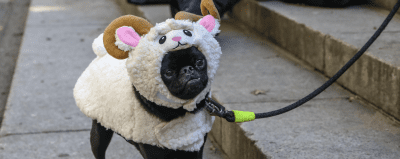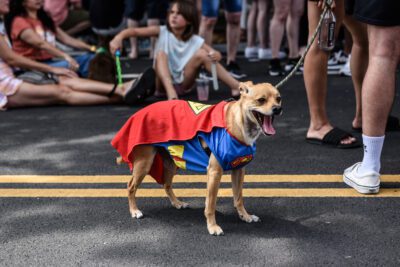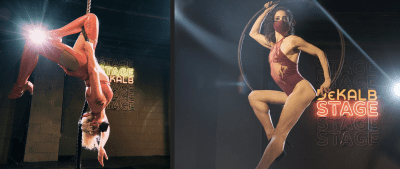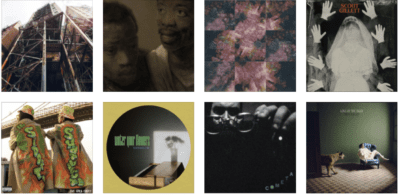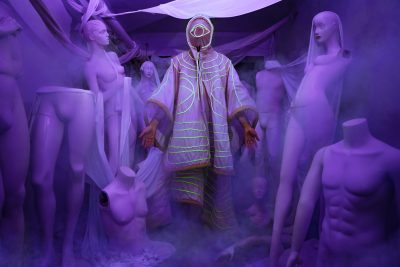Photo illustration by Johansen Peralta
Building Black Bed-Stuy is preserving the legacy of a neighborhood in transition
Kai Avent-deLeon — owner of the store Sincerely, Tommy and a founder of BBB — on fostering dialogue and uplifting her community
Like what you’re hearing? Subscribe to us at iTunes, check us out on Spotify and hear us on Google, Amazon, Stitcher and TuneIn. This is our RSS feed. Tell a friend!
There is a statistic that went super viral a couple years ago and continues to make the rounds from time to time online: The Brooklyn neighborhood of Bed-Stuy lost 22,000 black residents in the last decade, and in the same time added more than 30,000 white residents. That’s according to the 2020 census data.
Meanwhile, average median rent in Bed-Stuy for the first quarter of this year was $2,850. That represents a 26 percent jump from the first quarter of 2021. The neighborhood is changing. And it feels like the rate of change is speeding up. Its longtime historic and historically Black residents fear the neighborhood is losing its culture, its ability to serve as a safe space for them — and they’re feeling the squeeze. As the neighborhood gentrifies, residents are seeing an influx of new business and infrastructure improvements. But where were those improvements before, and what good do they do legacy residents if they’re being forced out of the neighborhood in favor of newcomers with higher incomes?
Enter Building Black Bed-Stuy. Launched in the summer of 2020 during peak pandemic lockdown and in the wake of the George Floyd and Breonna Taylor murders at the hands of police, Building Black Bed-Stuy is today a passion project of three women working to promote self-sufficiency and economic independence in the neighborhood. They raised funds for local Black-owned businesses and organizations that share their ideology and they kicked off an outdoor marketplace and block party series in front of the fashion and design store, Sincerely, Tommy.
This week on “Brooklyn Magazine: The Podcast” we’re speaking with one of the founders of Building Black Bed-Stuy, Kai Avent-deLeon, who is also the founding owner of Sincerely, Tommy (named in homage to Tomkins Avenue), which has become the de facto physical center of the Building Black Bed-Stuy movement. Herself a lifelong Bed-Stuy resident, Avent-deLeon talks about her upbringing in the neighborhood and how drastically it’s changed even in the past eight years. We’ll discuss the vision behind Sincerely, Tommy and the goals of Building Black Bed-Stuy, where she and her partners — Rajni Jacques, the global head of fashion and beauty at Snapchat, and Shani Coleman, the market coordinator for Building Black Bed Stuy and an entrepreneur in her own right — focus on solutions over problems. In two years they have amassed more than 20,000 Instagram followers who come for updates on their markets, block parties, community forums and more.
The following transcript of this podcast episode has been lightly edited for clarity and flow.
We actually had originally hoped to have all three of the Building Black Bed-Stuy lady bosses on the program, but scheduling didn’t work out. I’m really glad to have you for a number of reasons. You are the founding owner of Sincerely, Tommy. It’s a mix of fashion and accessories from a range of emerging designers. It’s a coffee shop, too, in Bed-Stuy. You opened it in 2014. Can you describe it to someone who’s never been? What is Sincerely, Tommy?
I guess the short bio is that it’s a lifestyle concept store. It did open in 2014, so we’ve been open for eight years. I am from the neighborhood of Bed-Stuy. I grew up there, and so I chose that neighborhood to open the business very intentionally. We were actually the first shop on Tompkins Avenue at that time. I think there was maybe two other businesses, but it was pretty much a ghost town. And so I knew I wanted this space that would really kind of be the catalyst to bringing together all of these creatives that were in the neighborhood and also just introduce a lifestyle element, with the fashion, the home goods, the coffee shop, the community and work that we were doing through this space. So it’s very multifaceted. It’s been so well received by the community both locally and internationally. And Building Black Bed-Stuy was birthed as an extension of that.
In 2014 Bed-Stuy, as you said, it was a very different place. You said [Sincerely, Tommy] was received positively. What was it like? Take us back to that moment where you’re opening this shop in an area where something like that hadn’t existed previously.
There were definitely some concerns, more locally about the way the store is positioned or maybe the external look of it. And so that was something to be expected because I was very firm in how I wanted the space to look, from a design standpoint.
How would you describe that design aesthetic to someone who hasn’t been to the store?
Honestly, just very minimal. I think a lot of people would see it and think it belonged in SoHo or just kind of an environment that housed more high-end spaces. But I knew for me it went deeper than that. I think as a Black woman, we’re often put in these boxes of things that we can do or ways that we’re supposed to express ourselves. And being someone that has this interest and passion for so many different areas, I felt like I wanted to go beyond those boxes. I wanted to create a space that really represented all of the things that I was interested in. And so for me it doesn’t have to look a certain way, it doesn’t have to be this thing that we’re used to. And Bed-Stuy is historically known as this Black neighborhood, but also just legacy. And I knew I wanted to create a legacy and it had to be something that stood out, that wasn’t the norm, that was very fresh and I kind of took that risk. Knowing that it was going to stand out.
It sounds like you had to walk a line between honoring the neighborhood, but you want to do something new. You don’t want that new thing to put off locals, or scare locals as a sort of canary-in-the-coal-mine of new, younger, hipper or possible-gentrifiers coming in. Was that something that you worried about? Or were you like, “Well I have a vision and I want to see this in the world?”
I definitely thought about it and considered it. I knew there would be some balance given the events that we would be hosting that were so focused on community. But I think for me it was just such a genuine act of self-expression that I felt like whoever is attracted to this space, to this brand, is going to be able to see what it stands for. And if they’re not, they’re not. Not everything that’s created in this world is for everybody, and that’s okay. I think I just stood firm in that.
You’ve been in BedStuy your whole life. Your family’s been there for decades, right? I read a bit about your grandmother, who came here when Bed-Stuy was an even more very different neighborhood than when you opened the store. Can you talk about your family’s roots in the neighborhood?
Both my mom and dad’s side, kind of two polar opposite ends of the spectrum, grew up in the neighborhood. My grandmother came here from Grenada, so she was an immigrant when she came here. And at the time I believe she was living in Far Rockaway and was working a few jobs and a colleague of hers mentioned that they were buying a brownstone and she was saving money at the time because she was a single mother of three. And so she heard this idea and was like, “Oh, that sounds like a good idea to buy a brownstone in Bed-Stuy,” not having ever seen one or even being to the neighborhood. Everyone thought she was crazy because Bed-Stuy was known as do or die back then. And so she ended up purchasing a brownstone for like $60,000.
Stop it.
Yeah, and it’s the one that I kind of grew up in between. And so she just kind of went on to do that for the rest of her kind of real estate career, if you will. I like to say that she kind of set the tone, or was a big contributing factor to so many things in that neighborhood. She would use her home as an art gallery for young local Black artists and it really did a lot for a lot of careers. And she also just helped young Black families buy their own brownstones, and would always instruct them to buy a multifamily homes so that they could live in the bottom units and then rent out the top floors and get that passive income. That was just her way I think of really helping our community grow within that neighborhood.
And it sounds — everything I know about you and what you’ve been doing — like you’re sort of an extension of that ethos. Talk about getting into retail, I think I read that your first job was at 16 and it took off from there.
My mom was like, “You’ve got to get a job.” I looked around, and I was literally going door to door and I went to Fort Greene. I remember there was this really cute boutique at the time and I went in there, gave my resume, and it was just like everything aligned. The owners took me under their wing. I was there for a few years and by the time I left I was assisting with the buying. And I just fell in love with the experience, not necessarily just the retail, but Fort Greene at the time was this hub for Black creatives of so many different industries. And being at that age, watching Erykah Badu and Mos Def and all these people who were masters of their craft was so inspiring and they would hang out in this space. And so I just knew I wanted to create something that had the synergy of being able to offer the art of these creatives and also house events that would focus on topics that were really meaningful to our community.
It’s funny that you mentioned Fort Greene and all of those incredible artists as well as your grandmother buying a house for $60,000 in Bed-Stuy. We [hosted] a series of movies in Fort Greene Park over the summer with Brooklyn Magazine. And one of the films we did was “Crooklyn.”
Oh, I have a good story about “Crooklyn.”
I would love to hear it. But it was amazing. Spike Lee actually came out and introduced the film, was an incredible moment. He told a story about how his mother first bought a house in Fort Greene. He said she got their house for $45,000. So probably around the same time as your grandmother, maybe even earlier. Crazy. So tell me your “Crooklyn” story.
That’s wild. I remember when they were filming “Crooklyn” because it was right off of Nostrand and I think, what is that? Hallsey? Yeah. And so we would walk by all the time and Spike Lee came up to me, I may have been five or six, I was walking with my mom and he was like, do you want to be an extra in the movie? And I was so young and nervous, so I just said, “No.” But once the movie came out, it became one of my favorite films because it was just so relatable. Like Troy was me.
Talk about Building Black Bed-Stuy then. You guys launched in 2020. You’re bringing local artisans together, you have weekly a marketplace, GoFundMe page, raising money for community organizations, you’re throwing block parties. What was the impetus to start this? You sort of addressed it a little bit with the similar impulse that your grandmother had and that you had with Sincerely, Tommy. But how is Building Black Bed-Stuy different? What’s the sort of galvanizing force there?
Obviously in 2020 there was a lot going on, or at least being publicized because we know these things have been going on for a very long time. Just having that space to be at home, because we were in lockdown at the time, really allowed me to focus in and feel like, “Okay, there’s a dire need here, but we can’t change the world.” How can we make some kind of impact, at least locally, given these two situations, meaning businesses are closed, this is a Black community, we can’t really afford to lose anymore spaces that are safe places for us. And so I reached out to actually a larger group of friends and I think there were six of us when we started and just presented this idea of, “Let’s gather, let’s do something.” And so after discussing, we came up with this idea of raising funds for businesses locally or organizations locally that would need the funding in order to stay open. Our mission really was to just preserve the legacy, build liberation through economic independence, and also just find ways that we could, I think, build a conversation around what’s essential to this neighborhood given the state of things. And the block parties were just like a celebration for the whole community. Always a lot of fun. We’re actually having our third block party on the 16th of this month, to celebrate two and a half years of BBB and eight years of ST.
I want to point out a statistic that’s been making the rounds on Instagram. You guys posted it. It said Bed-Stuy lost 22,000 Black residents in the last decade, according to the 2020 census. But added more than 30,000 white residents. I wonder if you can talk about the evolution of the neighborhood from where you sit, and what that stat, which is truly jarring, says to you specifically.
It was pretty apparent just if you’re a resident in that neighborhood who’s been there for the last 10 years, you can just see the drastic difference. I often say like, “oh my God, I’m the only Black person on this street right now.” Just walking down maybe Tompkins or Fulton and it feels very odd. It’s a tough conversation because I do think it’s a natural cyclical thing that happens in most neighborhoods, and I feel like it was just bound to happen in Bed-Stuy given the location, the charm, everything about it. I think it’s one of those natural progressions that just happens.
There is so much tension, there’s so much anger about what’s happening and unless you are there and in it, you don’t maybe necessarily experience it as much. It’s really simmering under the surface in a way that’s intense. Is there a healthy way to have this conversation?
We’ve actually done a couple of community forums at the store inviting both new and old residents just for that point that you mentioned, to see if there is a way to find solutions. And it’s just such a layered topic. It’s hard to just say, okay, here’s 1, 2, 3 solutions to fix this problem because I think it’s so much deeper. I was saying to someone, I personally didn’t realize that my mental health had been affected from this shift in the neighborhood, simply off the fact that growing up I was able to walk down the street and see other people who look like me, and that creates a sense of safety. And now when I walk down the street, that neighborly warmth that Bed-Stuy was built on is not there because so many people that are new in the neighborhood just don’t understand that a simple hello — or introducing yourself because you just moved in — those types of things that would always go without being said, don’t really exist as much. And it’s just this very entitled energy, where you almost just feel like, okay, damn … And then you also just think of the comparison. We would never be able to do this if it was the other way around. A group of Black people would never be able to take over a white neighborhood and be accepted in the same way with the same warmth. I think it speaks volumes to who we are, the root of Black people or African people in this country. We come from community, so we naturally just embrace because we want to create that synergy. But at the same time, I think the lack of understanding we have around ownership and the ability to thrive economically in this country because it’s just been taken from us in so many ways, also speaks in this shift. And it’s just so layered. I don’t think there’s a simple answer.
There isn’t, because there are positives that come with increased safety and livability and maintenance and all that, but then if you’re getting priced out, then it’s not your neighborhood and it’s hard.
But even with those types of changes, like the positives, it’s like, “oh, well damn Von King Park never had X, Y, Z growing up.” That was the dangerous park you didn’t go to. And now you go there and you see people like picnicking and there’s a dog park area, and things have been implemented into that space that would have never been considered just 10 years ago. It’s almost like, so this group of people isn’t good enough to receive those things that now exist. So yeah, it does come with some positive changes, but it’s also a reminder that so many things are set up to continue the oppression of Black and brown people and ultimately just keep us divided. Because I can go down a list of things that just didn’t exist in Bed-Stuy that do exist now.
Are there any businesses you want to shout out to our listeners?
I mean there’s so many, obviously Sincerely, Tommy, but Life Wellness, the Watoto Freeschool, or Saving Our Babies Inc., Little Sun People. Gosh, there’s so many. Sista’s Place. Ali’s roti shop. Greedi Vegan. [Avent-deLeon’s Doorbell rings, interrupting her train of thought.] Sorry.
Do you need to get that?
I got to move my car. It’s alternate side parking. Can I do that in five minutes? Is that okay? [She goes to move her car.]
That’s the most it’s the most Brooklyn thing in the world. Like, you have to drop everything and move your fucking car.
Yo, it’s so real. The number of times I forgot about it. Yeah.
They don’t even clean the street, they just move the trash around.
They don’t, it just flows around. I’m like, oh my God, this city and their quotas, man.
Tell us something about the other women who run Building Black Bed-Stuy with you since they couldn’t be here today to speak for themselves. Rajni Jacques and Shani Thompson. Talk about them. Who are they in the organization?
Rajni is a dear friend of mine. We’ve been friends for, oh my gosh, maybe about eight years now. And she’s a mom, wife, creative. She’s just a Renaissance woman. And Rajni and I actually talk about gentrification and just the overall changes in the neighborhood often. So her being part of BBB was just like a natural alignment. And she’s I would say a pro when it comes to knowing the facts and statistics about how, I guess not only gentrification came to be, but just the laws that were put in place within Black neighborhoods that allowed us to not be able to be homeowners and why we’ve been redlined, so many different things.
Shani, actually DM’ed us after BBB had started, just asking if we needed any help. And we desperately needed the help because we’re both moms and just have our own careers. And she just stepped right in. I can only say amazing things, like literally an angel that was sent, because she not only took on the marketplace, but just really stepped in with so much initiative of growing BBB, helping us in areas where we just weren’t able to give it the attention we wanted to. And she’s become so much more than just the market coordinator and she does it with a lot of love and just genuine desire to see these businesses and the vendors grow and get their brands out there.
I was looking through the [Instagram] account this morning, yesterday. I love a lot of what you do. You have a recent post about working to find solutions to issues like subprime mortgages still being offered in the neighborhood. Talk about that initiative, or at least what that initiative says more broadly about your mission.
We have an event coming up on the, at ST again, to have that forum, specifically around finding solutions and just opening up a dialogue around home ownership, what that looks like. Bed-Stuy is very priced out, so the average person can’t come in and say, “I’m going to buy a brownstone.” So what is the alternative? I’m a big fan of gathering resources, whether that’s literally gathering a group of friends and saying, we’re going to buy this property together. And also, to be honest, looking outside of this area, I think it’s very realistic that the average person cannot buy brownstone here anymore. So does that mean buying something upstate New York, buying land somewhere? It’s a conversation that we think can be had and maybe just shedding some light on what is more attainable at this point.
You’re using BBB to educate your followers. And it’s not just about gentrification and subprime mortgages, but you’re also talking about the history of the neighborhood, the fact that Bed-Stuy was once home to the country’s first free Black communities at the beginning of the 19th century. I’m assuming people are receptive to all this. Are people coming to you and saying, “I didn’t know that,” or “I think you should be doing more X, Y, Z?”
I would say it’s a blend. I definitely will look through the comments sometimes and it feels like people are very much ready to get into action. So that’s when these events come into place, it’s like, “Okay, let’s be constructive and we got to kind of reel in the reactivity of it.” But I think, yeah, it’s definitely a source of education. But as we’ve grown, I think personally I’ve also shifted from looking at these facts and automatically wanting to react versus [saying], “Okay, what’s the solution in this?” Because we can’t really change the fact that this has happened and continues to happen, but we can find areas where we can either grow or make some kind of progress. So what does that look like? And I think there’s plenty of opportunity. I know within our community we have a tendency to stay stuck and want to focus on what has happened or focused so much on the problem, and not come together to find where we can build something new. And that’s, I think, really what the root of this is is like we’re going to have to build something new and it’s going to take coming together and having camaraderie and not being victims.
So typical day in Brooklyn for you? Aside from having to do the alternate side parking. You have the day off, what does that look like for you?
I don’t really have a schedule. I’m trying to be better about creating a routine. I definitely love working out. I’m just big on self care. So I wake up, I meditate, I do breakfast for my son, drop him off at school, then come back, do my workout. I’ll usually do some computer work. I make it a point to take a walk because I just need to move my body more and be outside, but my days are smooth. I have surrendered to the fact that this whole “girl boss,” work slave thing, it’s just not my thing. I love rest.
Check out this episode of “Brooklyn Magazine: The Podcast” for more. Subscribe and listen wherever you get your podcasts.
You might also like 

















